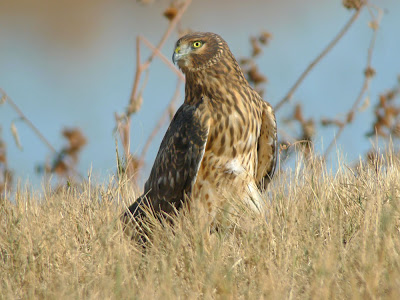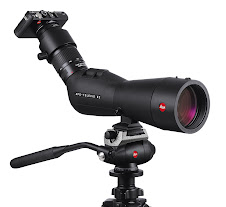
adult Red-headed Woodpecker digiscoped @ Fairhope, AL 10/2009
I recently returned from Fairhope, Alabama where I attended the Alabama Coastal Birdfest. The event was great fun even though a backlog of work kept me from enjoying many of the field aspects here. None-the-less, even with extremely limited field time I managed to find things to enjoy! Red-headed Woodpeckers are always a treat to observe and these birds seemed particularly abundant in and around the town of Fairhope. The bird digiscoped above was found on Saturday evening just a block south of the college where we displayed!

Brown-headed Nuthatch digiscoped Fairhope, AL 10/2009
Brown-headed Nuthatches also seemed quite commonplace and it seemed I heard their "rubber ducky-esque" calls any time I was near conifers in and around Fairhope. Of course seeing them on the trunk of a pine is not unusual but seeing one on a power line is!
Brown-headed Nuthatch digiscoped through Leica APO Televid 82 with D-Lux 4 camera
The nuthatch digiscoped on a low power line above (at least in my experience) was the first odd sighting I enjoyed and was able to get an image of. I was muttering under my breath, "Stay.. stay.. stay.." as I quickly set my scope up and slid the camera on to capture proof of the event.
dramatic skies at sunset Fairhope, Alabama 10/10/09
Being my first visit to the area, I used the last bit of fading light on Saturday to explore. I pointed my vehicle west knowing eventually I would find Mobile Bay and maybe a bird or two. Not surprisingly I saw Red-headed Woodpeckers and Brown-headed Nuthatches along the waterfront in the hillside pines here, but I was too late to see or hear much. I turned my attention to the dramatic sunset instead.
 digiscoped sunset, Fairhope, Alabama 10/10/09
digiscoped sunset, Fairhope, Alabama 10/10/09
As the sun sank below the horizon I was hoping for a green flash or similar when I had yet another unusual sighting.
 Canada Goose wrapped in reflected sunlight
Canada Goose wrapped in reflected sunlight
The brilliant reddish-orange sunlight reflected off the water and framed Canada Geese sitting at the shore in a cool brilliant halo or aura. Unfortunately, I was not able to capture this as vividly as it appeared to my eye, perhaps due to the scope coatings designed to control stray or reflected light?!?... I don't know, but it was still neat to see and I couldn't ever remember seeing this effect so vividly.
 Eastern Phoebe digiscoped with Leica APO Televid 82, Fairhope, AL 10/11/09
Eastern Phoebe digiscoped with Leica APO Televid 82, Fairhope, AL 10/11/09
On Sunday evening, I was making my way toward the Mobile airport enjoying the numerous migrants that had come in on the NW winds. Yellow-rumped Warblers and Indigo Buntings were calling everywhere. I watched a tired Eastern Meadowlark and a Yellow-billed Cuckoo drop into the small waterfront park near lunch.
I decided I had time for one last stop on my way to the airport near 3 PM so pulled into the 5 Rivers Nature Center on the causeway back to Mobile. Eastern Phoebes and Bluebirds were en force here. I found my first Golden-crowned Kinglet of the fall and saw 2 different Yellow-bellied Sapsuckers here.
 Eastern Phoebe, 5 Rivers Nature Center, AL 10/11/09
Eastern Phoebe, 5 Rivers Nature Center, AL 10/11/09
I'd been enjoying great photo ops all day and had been lucky/quick enough to capture 2 odd sightings in a row. I should have known my luck would soon change. After digiscoping yet another Eastern Phoebe and a male Pine Warbler, I laid my scope across the back seat and my trusty point & shoot on the passenger side floor. I continued down the main park road passing the canoe & kayak launch, viewing Northern Mockingbirds and Brown Thrashers teed up at roadside, eventually reaching the proverbial "end of the road".
It was near 4 PM and the road ahead went from pavement to gravel/shell and the sign here instructed that this was accessible by employees only. As I prepared to turn around I looked out the driver's side window. A bird perched on a low fence near 40 feet away, lifted off and flew directly away up a small slope. The lighting was perfect and I noted a pale gray back and contrastingly dark tail that was splayed out and slightly notched. The bird hung and wind hovered for a bit before dropping to the ground. The shape, and color pattern struck a familiar chord and I knew that bird wouldn't be likely here so I quickly glassed it.
I noted the relatively uniform light gray head and upper back, before it lifted off and flew directly back to perch on the short fence. My initial suspicions were confirmed as I saw the unmistakable peachy underparts of a Say's Phoebe! It was so close, I was certain it would spook if I stepped out. Instead, I turned and detached my scope from the tripod in the back seat and was beginning to attach it to the car window mount when my luck ran out. The bird lifted off and paralleled the river here. With a strong wind to its back, the bird quickly drifted further and further away... 100... 200 yards then it swept across a side channel and dropped out of sight behind a large white house.
It appeared the bird had landed but my view was blocked by the taller stream side vegetation here. I spent the next few minutes looking for lingering birders but only dog walkers and folks coming in for an evening meeting of sorts.... not a binocular in sight. I tried calling the few birder's numbers I had, leaving message after message but it was time to go. I reluctantly loaded up and headed back under the tunnel to catch my flight. A good bird seen but unfortunately not confirmed.
Worse yet I had been unable to share this rarity with any locals and with light fading and no one contacted it was unlikely anyone would even get a chance to find it until the following morning. It was neat seeing a bird like this far out of its normal range, but I'd seen Say's on both of last two trips to Monterey & Colorado respectively. I know from past experience what an exciting experience seeing this bird would have been to most in the local community.
C'est la vie! You win some, you lose some. The score this time was Birds 1, Birder zero. Still win or lose, I always enjoy playing the game and had a wonderful day on the shores of Mobile Bay!
 falcon species #3 a distant, backlit Merlin in harsh light!
falcon species #3 a distant, backlit Merlin in harsh light!

























 After surrendering the Peregrine to the darkening sky, I hoisted my scope & tripod and slowly retired for the evening. Still enjoying the rush from the spectacle I'd enjoyed!
After surrendering the Peregrine to the darkening sky, I hoisted my scope & tripod and slowly retired for the evening. Still enjoying the rush from the spectacle I'd enjoyed!


















 Kim Kaufman displays her badge of honor left from the cool Goliath Beetle!
Kim Kaufman displays her badge of honor left from the cool Goliath Beetle!






